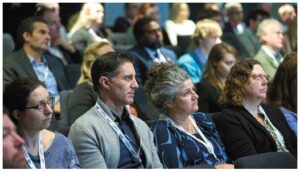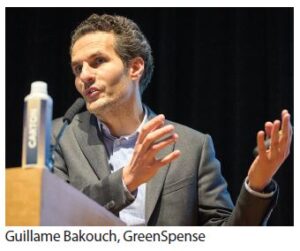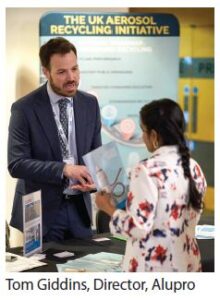Written on: July 1, 2023 by Patrick Heskins
Way back in 2017, BAMA organized its first Innovation Day at the Museum of Science & Industry in Manchester. Patrick Heskins, BAMA Chief Executive, remembers how the whole thing started and summarizes the 2023 program.
“When I was interviewed for the position of Chief Executive, I mentioned to the interview panel that I believed innovation was key to the future of the aerosol industry, and part of my mission would be to try and share new ideas with BAMA’s member companies,” explained Heskins.
“‘How will you do that?’ I was asked, to which I replied, ‘I will try and create an open platform for anyone with a new idea they would like share.’ From this simple conversation, BAMA Innovation Day was born.”

From a modest 40-strong attendance at that first event in Manchester, the event welcomed 150 visitors in 2023.
“For me, there is nothing more dispiriting than attending a populated event, and having only 10 people in the lecture room, listening to the PowerPoint you have spent weeks slaving over,” Heskins noted.
“Therefore, at this event, we take everyone into the lecture theater but give them the chance to meet the presenters at their tables in the adjoining hall during extended coffee breaks.”
This year, in conjunction with sponsor Lindal Valve, BAMA opened the day with a summary of the non-methane volatile organic compounds (NMVOCs) Pathway it developed with members during the last year to help Industry reduce its atmospheric emissions.
Jonathan Gawtrey of L’Oréal presented on Nature’s Aerosol Generators. Attendees got a “wonderful start to the day, with a video of the bombardier beetle spraying benzoquinone over potential aggressors.”

Alupro used the Innovation Day to launch its project to improve and increase the recycling rate of aerosols cans in the UK.
“As there is more and more pressure on packaging generally, the importance of having a robust system to collect and recycle aerosol is more important than ever,” Heskins pointed out.

Sticking with the sustainability theme, Weener Plastics highlighted its range of one-piece actuators and spray caps, which now have a very neat tear tab to enable simple removal for recycling.
Thomas Schuffenhauer of AFA Dispensing discussed the Flairosol trigger sprayer, which mimics the functionality of an aerosol can, while Dr. Keith Simons of SHV Energy explained the production of bio-propane and bio-butane for off-grid gas users, which might be a source of aerosol propellant gas in the future.

PolyTag, who produce serialized QR codes that allow every product to have a unique code no matter how many millions are produced, noted that the technology could help encourage curbside recycling should the deposit return system (DRS) be mandated in the future.
Fillinfinite showcased its desktop-sized machine, which looks much like a Nespresso coffee maker, that can refill a bag-on-valve (BOV) aerosol. Fillinfinite made its presentation in conjunction with GreenSpense, who have created a non-aerosol continuous spray system that utilizes a novel and patented rubber sleeve that fits over a BOV to squeeze out the product.
Paul Sullivan of DH Industries/Pamasol explained the problem of fugitive emissions from aerosols during the filling process and solutions that could significantly reduce this gas loss with relatively modest changes to equipment. Heskins noted that the potential savings are quite extraordinary.

Oliver Selby of FANUC presented on behalf of the British Automation & Robotics Association. On an aerosol line, the filling of the formula and pressure filling the gas is usually highly automated—however, could the aerosol industry give greater consideration to automation at the front and back end of the line, even when there are numerous different SKUs to handle? Selby explained how robots could be used by aerosol fillers, even in an ATEX environment (ATEX is an EU directive that defines and classifies hazardous locations, such as explosive atmospheres).
Enrique Garcia, Chief Technology Officer at the National Composites Center, explained the world of composites and how they are being used more as pressurized vessels with a capacity to resist chemical attack and extremely high pressures.
“A composite aerosol container might be some time away, but the potential for this material to be used for bulk storage of liquefied gases is probably not too great a leap,” commented Heskins.
The co-founders of Hungarian firm Re-Spray explained the design of their refilling machine, which is already installed and working in-store in Hungary, allowing users to refill a “pressurized dispenser” up to five times before it needs to be recycled.

Alan Murphy of Avanti Gas explained another system that could produce aerosol propellant gas from renewable feedstock—rDME. Avanti, as part of a joint venture called Dimeta, has recently started production of rDME from a demonstration plant just outside of Birmingham, UK, with a capacity of five tonnes a day. This will be scaled up at a new plant in Teeside, UK, and there are further plans to produce in the EU and the U.S. As with bio-propane, the initial target market is off-grid gas, but it’s only a small step to make gas suitable for aerosols.
The day was bought to a close by Roberta Sironi from Precision, the company that gave us the modern-day aerosol valve. Precision has recently launched its STORM technology, which gives a similar performance to two and three piece actuators—but from a one-piece design. This reduces complexity, weight and makes them simpler to recycle. SPRAY